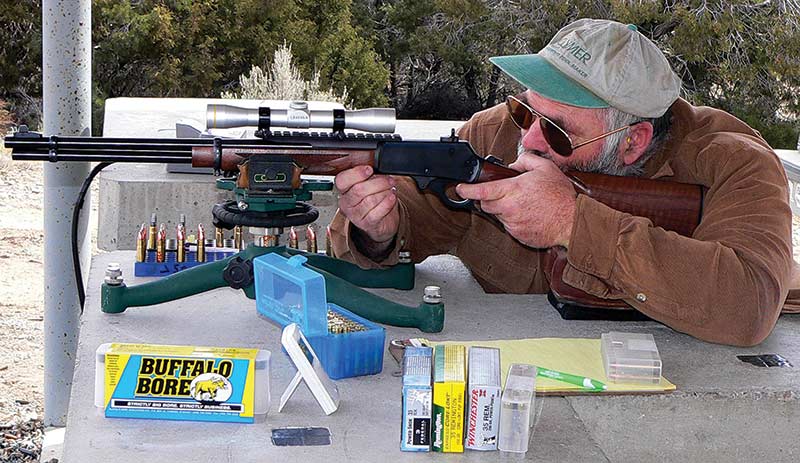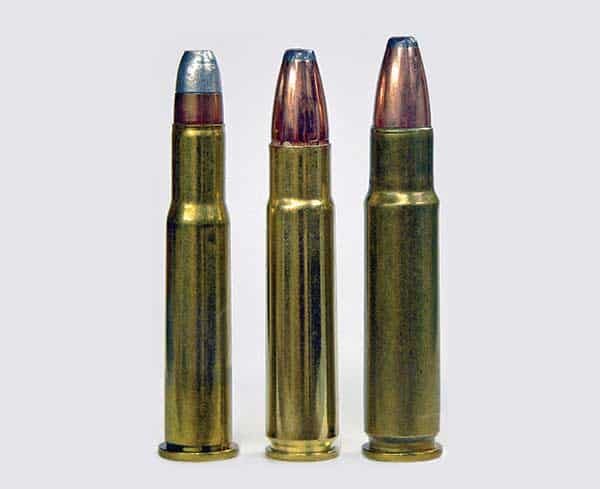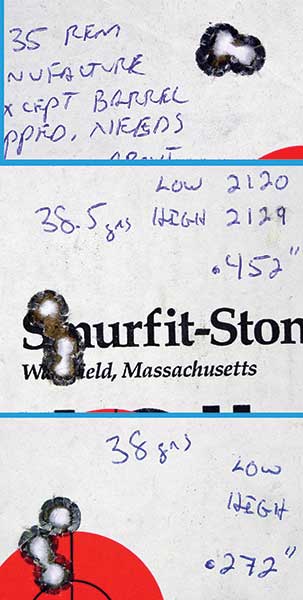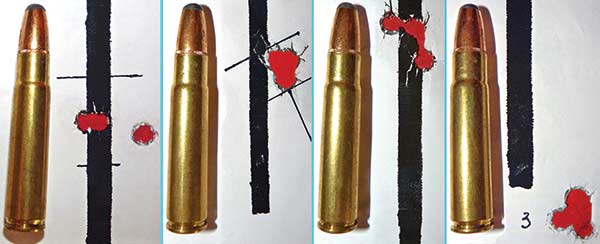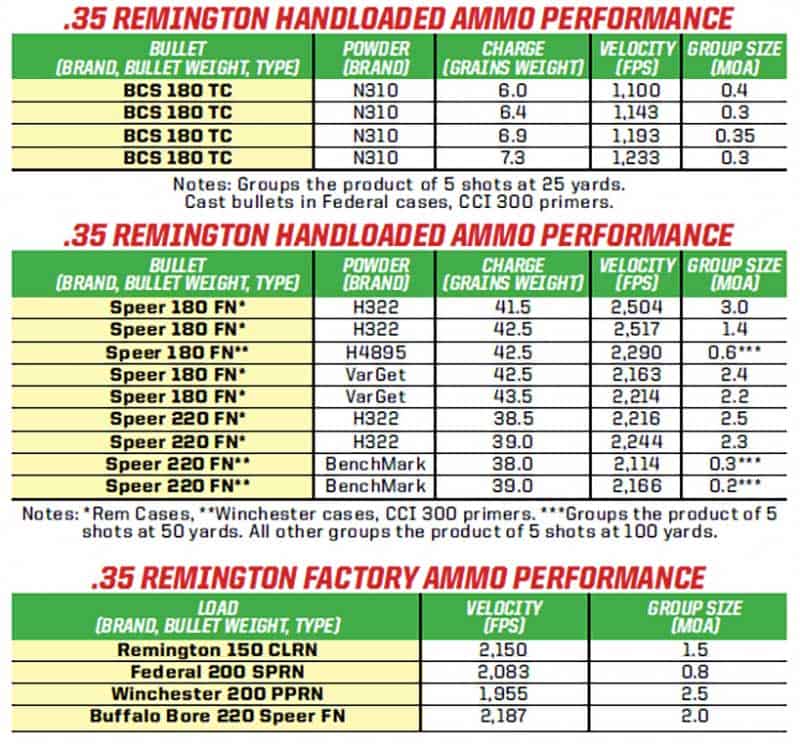Levergun Cartridge Supreme
For Over 100 Years, The .35 Remington Has Been America’s
Unheralded Close-Cover Big-Game Getter
When tallying fine hunting cartridge and gun combinations, the gun press has more-or-less ignored the fact the .35 Remington in the Marlin 336 or a hunting handgun should probably be near the top of any list. No reasonable person could possibly dispute the effectiveness of the Marlin 336 in the hands of most big-game hunters in most situations. Equally, this chambering in a hunting handgun is a well-proven, world-class option. Typical .35 Remington ballistics far surpass .30-30 ballistics. With best modern factory loads or optimum handloads, the .35 is adequate and appropriate for use against all but the largest species.
In 1895, Winchester started a revolution with its introduction of the first smokeless-powder hunting cartridge, the .30-30. In an era when 1,400 fps was considered hot stuff, the original .30-30 load launched a 165-grain bullet at 1,950 fps. The load proved effective for hunting smaller species of North American big game.
In 1906 Remington introduced a far more powerful cartridge, the .35 Remington. Marlin eventually recognized the value of the .35 Remington chambering and has offered it in its 336 since just after WWII, and this chambering has long been a popular option in hunting handguns.
Original .35 Rem factory loads launched 200-grain bullets at about 2,050 fps and therefore produced about 25 percent more muzzle energy than .30-30 loads. However, through subsequent decades, ammunition manufacturers approached the loading of these cartridges with diametrically opposite philosophies. For the .30-30, manufacturers took advantage of advances in propellant technology to improve ballistics, while loading at the same pressure. Conversely, for the .35, manufacturers took advantage of advances in propellant technology to reduce load pressure, while steadily reducing velocity! Therefore, as the decades passed, differences in muzzle energy between the best factory .30-30 and .35 loads narrowed down to insignificance.
Recently, Federal has begun to turn this situation around. Its current .35 Remington load launches a 200-grain bullet at almost 2,100 fps. Energy of this load far exceeds energy of any factory .30-30 load.
SAAMI should establish a +P .35 Remington specification, with 15 percent greater pressure. This would match .30-30 pressure. It would allow loads generating about 100 fps greater muzzle velocity.
Meanwhile, Buffalo Bore Ammunition’s .35 Remington load takes full advantage of the existing SAAMI pressure specification and modern propellants. This load launches the excellent Speer 220-grain Hot-Cor at 2,200 fps, which is faster than any standard .30-30 load actually launches a 170-grain bullet. Regardless of load, the .30-30 is a marginal elk cartridge. Conversely, with best modern loads, the .35 Remington is fully adequate.
Generally, while benchtesting any lever-action rifle is difficult, the Marlin is an accurate gun. When hunting, it is a rare person who can hold one well enough to exercise this accuracy potential. And, how much accuracy do you need when trajectory and retained energy limitations suggest shots on big game should not exceed about 200 yards?
Among all chamberings offered in the 336 Marlin, guns chambered in .35 Remington are the most accurate. While the following might be difficult for some bolt-action fans to accept, these guns routinely beat the MOA-accuracy standard for three shots at 100-yards. And, as the included pictures of test groups clearly demonstrate, accuracy far surpasses what is actually needed for any appropriate and reasonable big-game hunting application.
The following results represent what I saw with one gun during maximum-load development work—I was only interested in velocity. Surely, by investing more time, energy and money into load development I will find better accuracy; however, other than proving the “potential accuracy” point, such an investment would be of little value.
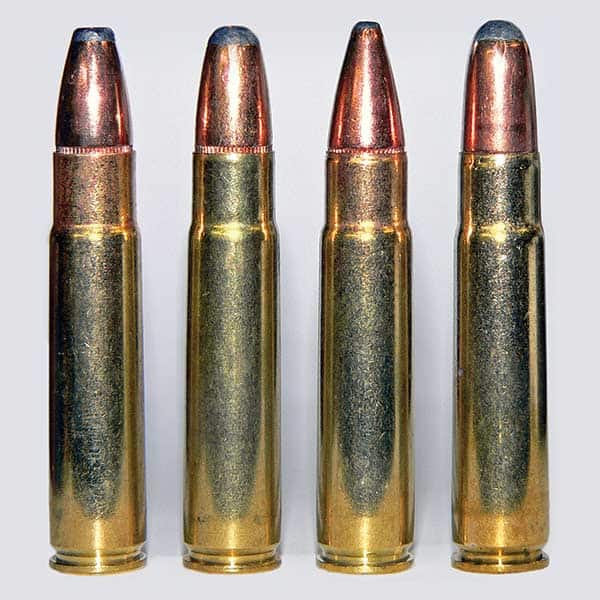
Factory loads tested included (left to right) the Buffalo Bore topped with a 220-grain
Speer FN bullet at 2,187 fps, the Federal 200-grain at 2,083 fps, the Remington 150-grain
at 2,150 fps and the Winchester 200-grain at 1,955 fps. Remington could easily load their
unusually efficient 150-grain bullet to 2,550 fps, which would make a far more interesting load.
The Ballistic Coefficient of this bullet is similar to the 200-grain roundnose bullets, but the BC
of the 220-grain FN is about 25 percent better.
Marlin And Handguns
While the .35 Remington Marlin 336 has always intrigued me, it took me the better part of a lifetime to finally own one. Much as I enjoy the other Marlin 336 chamberings, if I could only own one 336, it would now probably be a .35 Remington.
Among the almost endless chambering options for a 1-hand hunting gun, the .35 Remington offers the best combination of recoil, delivered energy, terminal performance and ammunition availability. Again, if I were hunting North American game with a handgun, it would be chambered in .35 Remington.
When using typical propellants, a charge generating 40,000 psi in a new Remington case would generate almost 45,000 psi in a new Federal case.
Of the modern cases I tested, Remington case necks were about 5 percent thicker than Winchester or Federal case necks. This might suggest an advantage in using the Remington cases, owing to greater neck tension and superior bullet centering and alignment. However, this modest difference is probably more-or-less insignificant and other brand-to-brand variations are also important.
In my opinion, all .35 Remington handloads for the Marlin should use CCI Large Pistol primers. Due to the relatively low-striker energy, pistol primers give more uniform ballistics, and such modest charges of easily ignited propellants do not require rifle primers. For extruded propellants, the CCI-300 is the best choice; for ball-type propellants, the CCI-350 is the best choice.
If using pistol primers makes you nervous, the best alternative is match-grade rifle primers. Compared to the CCI-200 or the Federal 210, the CCI-BR2 and the 210M give better accuracy and ballistic uniformity. (Likely, these match-grade primers ignite more consistently in response to the relatively light striker impact.)
When handloading for tubular-magazine rifles generating significant recoil, I prefer combinations where bullet seating significantly compresses the charge. This eliminates the potential for recoil battering to drive bullets into cases in rounds in the magazine. In this regard, H322, Benchmark, AA2495, IMR4895, and H4895 are fine .35 Rem. choices. For those interested in top-end loads for use in only strong, modern guns, H322 is probably the best choice among conventional propellants. When loaded to the same pressure, LEVERevolution—the high-performance propellant from Hodgdon—will give about 100 fps greater velocity than any conventional propellant will. Such .35 Rem loads generate as much energy as typical .30-06 factory loads do. For heavy cast bullet loads, AA2495 is unbeatable.
In standard .35 Rem loads, hunters interested in expanding bullets will never need anything other than the Speer 180- or 220-grain flatpoint. These Hot-Cor bullets have very impressive BC’s (0.240 and 0.301, respectively) and, terminal performance is comparable to that of the best premium hunting bullets. For top-end loads at higher-than-standard .35 Rem pressure, Alaska Bullet Works’ bonded-core 250-grain bullet will provide maximum terminal performance on moose and big bear—double caliber expansion and practically 100 percent weight retention. For applications where a non-expanding bullet is preferred, several companies offer excellent cast bullets, which work well when loaded at full pressure.
Those interested in a rifle for use in hunting most species of North American game, and many similar species worldwide, will find with the right loads the Marlin 336 in .35 Remington is a handy and capable combination. While inappropriate for shots beyond about 250 yards (even with best bullets and loads, limitations of trajectory and retained energy quickly mount), this combination is fully adequate for most hunting situations.
Similarly, handgun hunters will find that the .35 Rem chambering offers splendid performance. The factory loads that are available worldwide will certainly get the job done.
Is the .35 Rem better than the .30-30? In every category excepting recoil, the .35 Rem has a significant edge. Those who are only interested in using top-end loads and who are particularly sensitive to recoil will find that the .30-30 a better choice because shot placement always trumps delivered energy and, for most of us, a gun generating less recoil is easier to shoot accurately.
Handloaders will find the .35 Rem offers significant advantages. For example, myriad inexpensive cast and jacketed .357 Magnum bullets for plinking are available, and the .35 Rem is an outstanding cast-bullet cartridge. And, as noted, sufficient jacketed bullet choices exist to cover any big-game hunting application.
After more than a century of serving hunters well, perhaps the .35 Remington can finally begin to receive the recognition it deserves. The introduction of +P factory loads would certainly encourage this.
